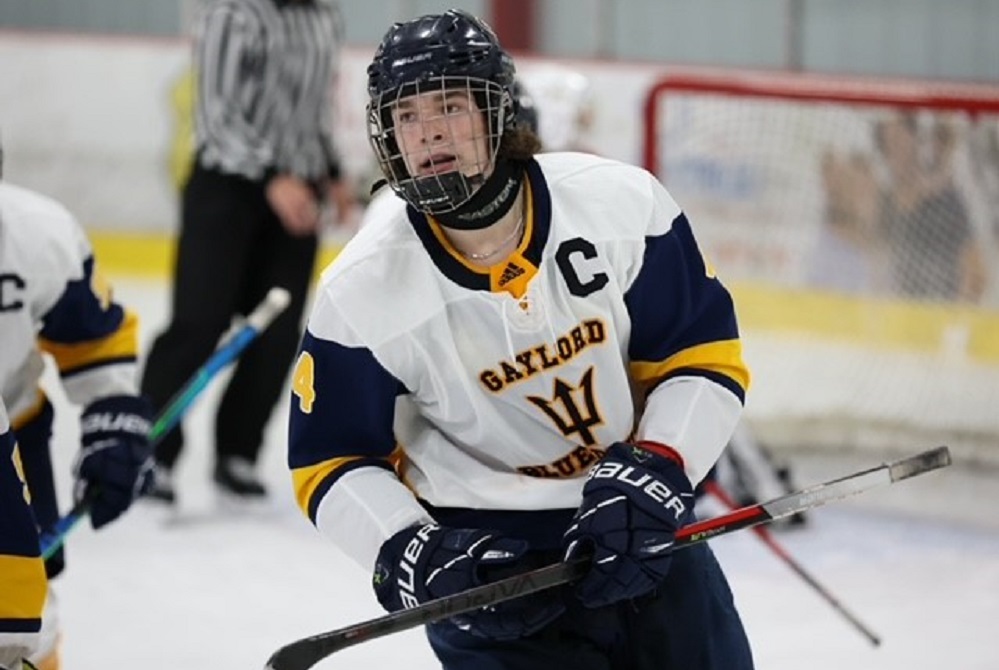
Gaylord's Looker Shows 'Different Type of Tough' in Return from Knee Tear
By
Tom Spencer
Special for MHSAA.com
February 3, 2023
When Gage Looker went down with an ACL injury in Gaylord’s first football game this fall, Liz Harding – president of the Blue Devils’ hockey boosters – was absolutely devastated.
 Looker, an all-conference hockey defenseman last winter, was playing, as a senior, in his first-ever varsity football game. Harding, also Looker’s mom, was there.
Looker, an all-conference hockey defenseman last winter, was playing, as a senior, in his first-ever varsity football game. Harding, also Looker’s mom, was there.
“I caught the one and only picture of him playing football just before he injured himself,” Harding recalled. “I was devastated!”
Doctors indicated surgery was necessary and recovery would prevent Looker from getting back on the ice, the football field and the track where Looker had dreams of great success this year.
“Knowing hockey is his passion — and thoughts of him not playing did not set well with me — Gage started what I would call standard physical therapy a couple days after surgery and then added an additional blood flow therapy with our local trainer to his weekly routine,” Harding said. “Through his hard work and determination, he is back on the ice.”
The Blue Devils, after graduating their other four all-conference players from last winter, were 2-11 this year when Looker returned to the ice against Big North Conference rival Petoskey. Gaylord has won three of seven since.
Gaylord coach Jamie Voss believes Looker’s return was pretty much a miracle. And he thinks Looker is playing at about 80 percent despite being only a few months removed from the injury.
“Gage tore his ACL and was told by doctors his sports life was over,” Voss said. “Gage would not accept this, and he trained harder than any kid I have ever witnessed to prove the doctors wrong.”
Sans injury, Voss notes Looker was certain to graduate on several all-time Gaylord hockey record lists.
“The reports on his progress and rehab were literally off the charts for this type of injury,” Voss said. “His doctors reported early that they have never seen this occur before regarding the strength developments in the afflicted areas that support his ACL tear.”
Voss admitted he had to hold his breath a little – as many Gaylord supporters did – when Looker joined the starting lineup against Petoskey. That moment came after just a week on the ice, including full contact practices.
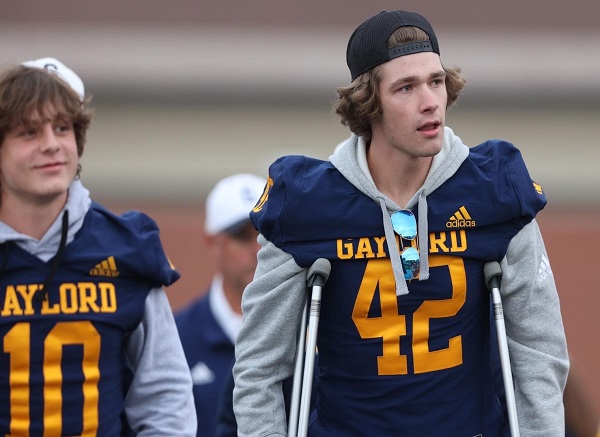 “More important than records to Gage was his commitment and obligation to be our team leader as our compete level was predictably down this season,” Voss said. “Gage is one of the best athletes and citizens that I have ever been allowed to coach.
“More important than records to Gage was his commitment and obligation to be our team leader as our compete level was predictably down this season,” Voss said. “Gage is one of the best athletes and citizens that I have ever been allowed to coach.
“He is not only a leader to the players on and off the ice, but Gage also is the kind of kid that coaches learn from,” Voss went on. “He is mature beyond his years.”
Looker, who started playing hockey at 4 years old, dabbled with football as a freshman although an eighth-grade hip injury kept him away from the field until this fall. Looker’s size – 6-foot-3, 245 pounds – led to many encouragements to give football another try.
“I went the rest of my high school career being told that I needed to play football,” Looker said. “So I said ‘why not’ my senior year because I could use the extra strength for hockey.”
Looker knew the morning after his one-and-only career football game that he needed medical attention promptly. A quick MRI showed extensive damage.
Looker was told he literally “blew apart” his ACL.
“My stomach dropped,” Looker said. “I was not ready for that at all.
“I was shown what my PCL looked like and then went to where my ACL should be, and it was gone — some say it was deleted,” Looker continued. “I was told I will not be able to play sports for about seven to nine months, and I was speechless.”
Two months after surgery and extensive physical therapy, Looker tried to skate. It went so well he began to entertain thoughts of playing hockey again. He may aspire to compete in track & field this spring.
“He runs a 56-second quarter mile and throws the shot put 48 feet, 10 inches,” Voss said of his dominating defender. “And although he is restricted from running, something tells me this kid will run track this spring.”
While it is not the senior hockey season it could have been without the injury, many are glad to just have Looker on the ice. His mom is among them.
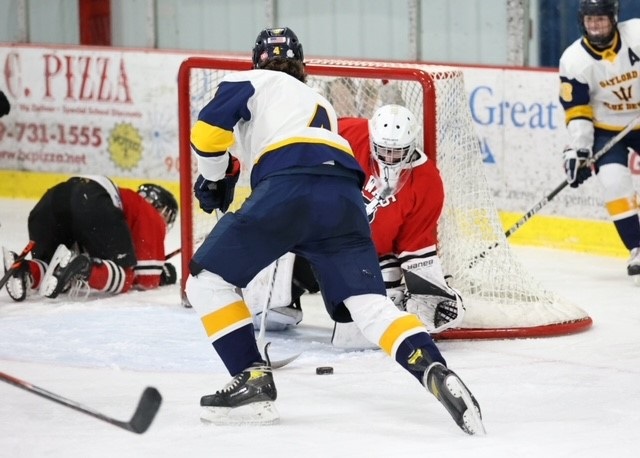 “I am overjoyed to have him back on the ice,” Harding said. “At least he is getting in a few games and is out there making a difference.
“I am overjoyed to have him back on the ice,” Harding said. “At least he is getting in a few games and is out there making a difference.
“The smile on his face is priceless,” she continued. “Perhaps he'll continue with track as he is set to break records there too.”
Rehab fresh out of surgery was “very boring,” so Looker started intensifying his recovery with therapy four days a week for a few months.
“It was a lot of commitment, but I needed my senior year of hockey,” Looker said. “I was doing the basic things, and then I had a machine that could stimulate my muscles and pump blood to my knee.
“It is called ARPneuro,” he continued. “I was skating with that on my leg as well as doing mini workouts at home.”
ARP — accelerated, recovery and performance — reportedly accelerates recovery time by decreasing chronic pain and increasing range of motion without the use of medications.
“I was always putting as much work in as I could,” Looker said. “It definitely paid off in the end.”
Looker’s coach agrees.
“I have never heard of this, nor witnessed it,” Voss said. “Gage Looker is an anomaly, and in my opinion a different type of tough.
“Gage returned to practice full contact three months after he tore his ACL,” Voss continued. “And he played his first hockey game logging 30 of 51 minutes a week later.”
Looker credits the support and effort of his medical team and his teammates for helping him get back on track. However, no one gets more credit that the booster president.
“My mom and teammates helped me through it,” he said. “My mom was always on me about doing my workouts and keeping me disciplined.”
 Tom Spencer is a longtime MHSAA-registered basketball and soccer official, and former softball and baseball official, and he also has coached in the northern Lower Peninsula area. He previously has written for the Saginaw News, Bay County Sports Page and Midland Daily News. He can be reached at [email protected] with story ideas for Manistee, Wexford, Missaukee, Roscommon, Ogemaw, Iosco, Alcona, Oscoda, Crawford, Kalkaska, Grand Traverse, Benzie, Leelanau, Antrim, Otsego, Montmorency, Alpena, Presque Isle, Cheboygan, Charlevoix and Emmet counties.
Tom Spencer is a longtime MHSAA-registered basketball and soccer official, and former softball and baseball official, and he also has coached in the northern Lower Peninsula area. He previously has written for the Saginaw News, Bay County Sports Page and Midland Daily News. He can be reached at [email protected] with story ideas for Manistee, Wexford, Missaukee, Roscommon, Ogemaw, Iosco, Alcona, Oscoda, Crawford, Kalkaska, Grand Traverse, Benzie, Leelanau, Antrim, Otsego, Montmorency, Alpena, Presque Isle, Cheboygan, Charlevoix and Emmet counties.
PHOTOS (Top) Gaylord’s Gage Looker has returned to the ice this season only a few months after a serious knee injury. (Middle) Looker, right, watches his football teammates from the sideline this fall. (Below) Looker tries to stuff the puck past Tawas’ goaltender. (Photos by Rob DeForge/RD Sports Photo.)
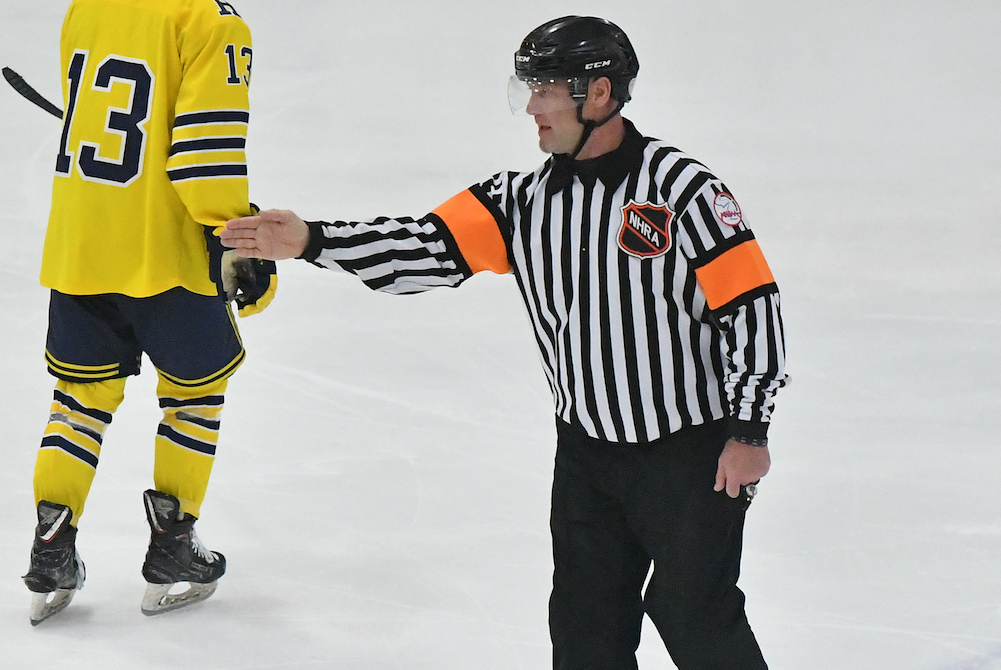
Retired NHL-er Back on Ice to Answer Call - By Making Them
By
Rob Kaminski
MHSAA benchmarks editor
March 16, 2023
The most accomplished skater on the ice during Friday’s triple-overtime MHSAA Division 1 Semifinal hockey thriller between Hartland and Brighton was not wearing the school colors of either team.
In front of a packed house at Plymouth’s USA Hockey Arena, referee Bryan Smolinski was in stripes, just like the rest of his officiating crew.
In his former life, he pulled on plenty of sweaters before lacing up the skates. That happens when one logs more than 1,000 games, tallies nearly 300 goals (274) and close to 400 assists (377) with eight teams spanning a 15-year playing career in the National Hockey League.
So, how did the 52-year-old former star player find himself on the ice last weekend as one of the referees for the pinnacle weekend of this high school season? Good question, even for the man known as “Smoke” during his playing days.
“I was working in youth development programs a few years back and reached out to some Michigan guys I had connections with about other ways to help the game,” Smolinski said. “I called Kevin May just to chat and asked, ‘Hey, how’s your reffing going?’ He said, ‘You know, we’re down a little bit,’ then said, ‘Why don’t you do it?’ I said, ‘Not a chance,’” Smolinski laughed.
Never Say Never
May persisted, imploring his friend to skate with him during a Fall league at Cranbrook in Bloomfield Hills. After eight weeks, once a week, Smolinski had a revelation.
“I’m like, ‘I’m kind of diggin’ this,’” Smolinski said “So, I did all the testing, and the educational part of it, and I really enjoyed it. I got with Danny (DiCristofaro) and his group, and he put me in as much as he could, and I really started to get my feet wet.”
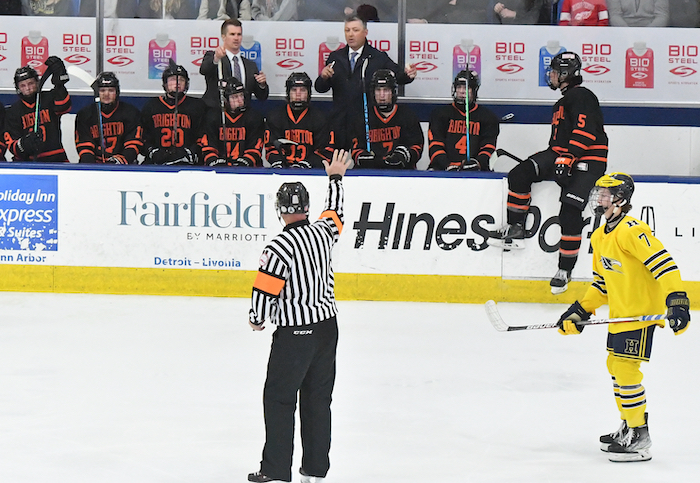 DiCristofaro is the assigner and referee-in-chief for the MHSAA’s Northeast Hockey Referees Association, and he has seen Smolinski’s growth first-hand.
DiCristofaro is the assigner and referee-in-chief for the MHSAA’s Northeast Hockey Referees Association, and he has seen Smolinski’s growth first-hand.
“Obviously he’s got great instincts and a feel for the game, along with a wealth of experience, all of which has allowed him to climb the ladder quickly,” said DiCristofaro. “It’s been a joy to watch his growth as an official.”
Fast forward to last Friday, and there were Smolinski and May sharing duties as referees during the MHSAA Semifinal with linesmen Michael Andrews and Thomas Robbins.
In between, there has been a learning curve that still continues, but the jump to officiating was not quite as daunting as his introduction to the NHL.
“I was scared to death. My first game was against Mario Lemieux. I’m in the old Boston Garden and now I’m playing against these guys and it’s their job, and they’re out there trying to make a living,” Smolinski recalled.
The emotions were not running nearly as frenzied for his first game as an MHSAA official, obviously, yet respect came in a different form.
“I couldn’t pick the puck up, I was breathing heavily; it was Kevin and me doing a two-man game in Brighton,” Smolinski recalled. “There were a few high-end kids playing, and I’m thinking, ‘I’m dying here.’ You know, there’s no training for that first time.”
What that experience did, however, was revitalize Smolinski in a new way. His playing career is well documented, not only in the NHL, but around Michigan. He enjoyed an honor-laden career at Michigan State University from 1989-93 before joining the Boston Bruins (who had drafted him three years earlier) at the end of the ’93 NHL campaign. Even after his final season, with Montreal in 2007-08, he stayed in the game via men’s leagues, or coaching his son, Max.
Smolinski and his wife, Julie, have three daughters: Ashtyn (22), Jojo (16) and Rylen (12), along with Max, whom dad coached for seven years including during a national championship run with a Little Caesars U15 team in 2019. Max, 19, is now playing collegiately at Rensselaer Polytechnic Institute.
So, for Smolinski, officiating offers a new chapter.
“Reffing brought back ... I wouldn’t say love of the game, because that’s always been there; it’s a different side of enjoying the game now. I have no horse in the race, my son’s off to college, my daughters are doing their thing; I wanted to find something new in the game,” Smolinski said. “I’ve coached, and I don’t want to do that. I found this, and I’ve stuck with it.”
Old College Ties
One of the great benefits of athletics at any level are the friendships made. For two kids who met in their first years on the MSU campus and forged a bond that lasts to this day, it’s amazing how their careers reached the pinnacle and have now come full circle.
Wes McCauley, an MSU teammate, is one of Smolinski’s best friends. After numerous years in the minor leagues, McCauley, like his friend, made it to the NHL. But McCauley made it as an official, working his first NHL game in 2003, when Smolinski was nearing the end of his playing career.
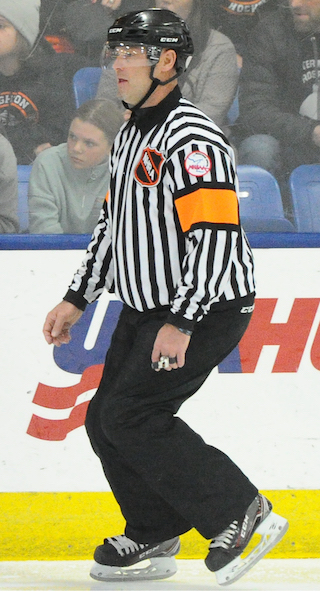 Their games lined up on just a few occasions in the NHL, and the two lobbied hard to have McCauley work Smolinski’s 1,000th career game in his final season with the Canadiens in 2007-08. The request, sadly, was denied by the league.
Their games lined up on just a few occasions in the NHL, and the two lobbied hard to have McCauley work Smolinski’s 1,000th career game in his final season with the Canadiens in 2007-08. The request, sadly, was denied by the league.
On the rare occasions when the friends did share the same ice, less than a handful by Smolinski’s count, it was McCauley who was forced to rebuff any attempts at fraternization. It’s just part of an official’s edict.
“For both of us, it was amazing; it was just great,” Smolinski said. “I’d say, ‘Hey man what’s up?’ and he says, ‘Can’t talk.’ I’m like, ‘What do you mean, we talk all the time.’ Again, he’s like, ‘Can’t talk, get away from me.’ You know, it was just business.”
McCauley then reached the 1,000-game plateau himself in 2018 and is still going strong as a regular selection for playoff duties with nine Stanley Cup Finals assignments, including last year.
So, it should have been natural for Smolinski to go to his old friend immediately for officiating pointers once he joined the ranks, right? Well, maybe not immediately.
“I talk to Wes all the time, but I actually hid it from him right out of the gate because I didn’t want to take his razzing. Eventually it got out, and he was loving it. He started sending me whistles and visors and pants,” Smolinski said, grinning. “And none of it fit, you know, because I’m older and fatter, and he’s so damn skinny. So, I still had to go out and get all new gear.”
Both Sides Now
Having been to the top of his profession, now moving to the other side of that same mountain that his friend McCauley scaled, the respect has grown for those blowing the whistle.
“The preparation for officiating is much more mental,” Smolinski said. “Way more rules oriented. You’re always trying to get away with things that you can as a player; now you have to police that.”
Smolinski has a distinct advantage.
“I know everything they’re trying to do because I’ve done it. I know where you’re going with the puck, I know what kind of breakout you’re trying to do,” Smolinski said. “I have all the instincts, now I just try to stay out of the way and not ruin their game. The most fun is watching the game develop and the ups and downs. For me to be out there and enjoy it with them, that’s the fun part.”
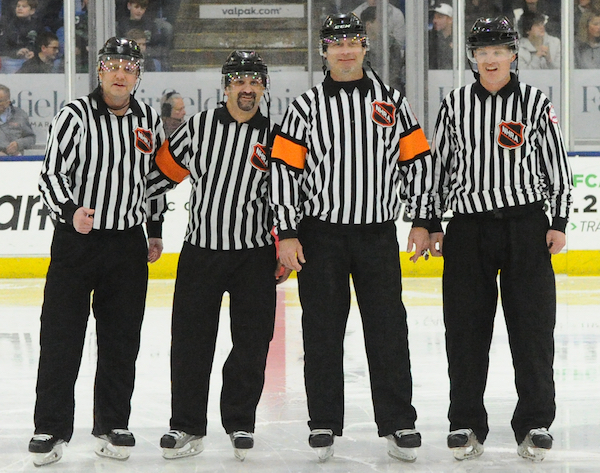 Those who have played hockey at any level have a built-in advantage should they consider the officiating avocation: the ability to skate. Unlike officiating in any other sport, skating is a prerequisite. This makes the pool limited, and almost solely composed of former players. Smolinski offers this advice.
Those who have played hockey at any level have a built-in advantage should they consider the officiating avocation: the ability to skate. Unlike officiating in any other sport, skating is a prerequisite. This makes the pool limited, and almost solely composed of former players. Smolinski offers this advice.
“I prefer sticking with high school because I think there’s more decorum, more administrative structure. Kids are playing for their schools, there’s loyalty there,” said Smolinski. “And there is more accountability. People need report to athletic directors and supervisors. Other levels can be more loosely governed, or a bit more maverick in nature. Moms and dads get involved more, coaches maybe know a little less,” said Smolinski.
He has, in fact, worked a handful of non-school games, and there’s a stark difference.
“I wanted to see what was going on, and I see it first-hand,” Smolinski said. “There are some crazy people and parents out there, and these guys are getting absolutely tortured. I’ve been tortured. There has to be a level of respect for what officials do. I think schools can rein that in a little more. All the guys I’ve met give up a lot of time and work hard because they love to do it and love the game.”
All sports need an assist from school administration and from those who once played the games to keep the officials recruitment moving in the right direction. People like Smolinski can help.
“He clearly doesn’t need to do this, and that’s what makes it so fantastic,” DiCristofaro said. “We need more people who have played – at any level – to do what he’s done and stay in the game as officials.”
Smolinski continues to promote the game in other ways as well. Currently, he is involved in the NHL’s Learn To Play initiative, which aims to inspire youth and welcome more families into the hockey community.
“We work hand-in-hand with the NHL Players Association for player development and industry growth,” Smolinski said. “Ages 5 to 9 are introduced to hockey, get head-to-toe gear and instruction, and meet some former players.”
The idea is to have fun first, which can translate into years and maybe even a lifetime in the sport. It’s a lifetime that has given Smolinski so much and continues to do so as he watches it unfold for others from his new vantage point.
PHOTOS (Top) MHSAA official Bryan Smolinski signals during Friday's Division 1 Semifinal between Brighton and Hartland. (2) Smolinski, a retired NHL standout, communicates with the Bulldogs' bench. (3) Smolinski keeps watch during game play. (4) Smolinski, third from left, with his crew: Michael Andrews, Kevin May and Thomas Robbins.

